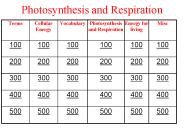Chlorophylle PowerPoint PPT Presentations
All Time
Recommended
Regionalization of Gulf of Mexico using SST and Chlorophyll-a images. Olivia Salmer n-Garc a ... Chlorophyll-a concentration. Cloud detection and Hurricane ...
| PowerPoint PPT presentation | free to view
Chlorophylle une certaine poque, on pr tait toutes sortes de vertus la chlorophylle. quation g n rale de la photosynth se CO2 + H2O CH2O + O2 Plus ...
| PowerPoint PPT presentation | free to view
... mitochondries Pr sence possible de chlorophylle h t rotrophe autotrophe si chloroplastes autotrophe si chlorophylle Pas de chloroplastes Pas de vacuole ...
| PowerPoint PPT presentation | free to view
Chromatographie de la chlorophylle En faisant des recherches, nous avons trouv que la chlorophylle est une substance verte, fabriqu e par la plante, ...
| PowerPoint PPT presentation | free to download
However, you are not employing pure chlorophyll when you use chlorophyll drops. Chlorophyllin, a semi-synthetic blend of sodium copper salts generated from chlorophyll, is the green liquid supplement dripped into beverages..
| PowerPoint PPT presentation | free to download
... = Bl te kyanos (gr.) = blau Meist im Zellsaft gel st; hydrophil ( Chlorophylle, Carotinoide) Chromophore Gruppen unterschiedl. Struktur unterschiedl.
| PowerPoint PPT presentation | free to download
... entre ondulatoire continu et corpusculaire discontinu Rhodopsine lumi re nergie lectrique nerf optique Chlorophylle lumi re nergie ...
| PowerPoint PPT presentation | free to download
... les champignons (ne se d placent pas, pas de chlorophylle), les protistes (unicellulaires) Les bact ries ou mon res (unicellulaires sans noyaux).
| PowerPoint PPT presentation | free to view
Chlorophylls Contributes to fighting harsh diseases 2.Carotenoids Vitamin A Antioxidants ... vegetables, and even animals. Found mainly in plants, algae, and ...
| PowerPoint PPT presentation | free to view
Cop pode Salpe Taille
| PowerPoint PPT presentation | free to view
Si la chlorophylle se d grade plus vite qu'elle n'est synth tis e, on voit alors appara tre les autres pigments. une certaine poque, ...
| PowerPoint PPT presentation | free to download
... D origine v g tale : jaune extrait de la graine d un arbuste le roucouyer, vert de la chlorophylle, rouge b tamine de la betterave, ...
| PowerPoint PPT presentation | free to download
Noyau. Spirogyres. Filaments de chlorophylle. Paroi de la cellule ...
| PowerPoint PPT presentation | free to view
... la maturation des fruits, la mise en place de la couleur (inhibe chlorophylle) Inhibe germination des graines et croissance des racines Similitudes avec ABA, ...
| PowerPoint PPT presentation | free to view
Photosynthetic pigments are chlorophylls a and b. Chloroplasts have ... Micromonas very small, marine flagellate, single flagellum, primitive ... biflagellate ...
| PowerPoint PPT presentation | free to view
2 RH2. 4 . Scission de l'eau. Chlorophylle excit e. Chlorophylle. Energie. lumineuse. ADP Pi. ATP. Energie. lumineuse. 2 R. 4 . 2R 4 . 4 H O2. 4 . 2H2O. 2 RH2 ...
| PowerPoint PPT presentation | free to view
carbon dioxide = auto. organic compounds = hetero. 5. Chemoautotroph. Energy source ... carotenoids, accessory pigments. chlorophylls. 15. Carotenoids ...
| PowerPoint PPT presentation | free to view
The best known form of photosynthesis is the one carried out by higher plants ... varieties of chlorophylls and other accessory pigments such as beta-carotene ...
| PowerPoint PPT presentation | free to view
chloroplasts with chlorophylls a and b. charophyceans (closest ... walls contain sporopollenin which makes the spores touch and resistant to harsh environments ...
| PowerPoint PPT presentation | free to view
In the subsequent s the background color of the ... Alkaline conditions. Under alkaline conditions the methyl and phytyl esters are removed, producing ...
| PowerPoint PPT presentation | free to view
... of chlorophyll resembles the structure of the haem group in animal blood) ... strong tendency to lose electrons and donate them to other substances, it is ...
| PowerPoint PPT presentation | free to view
Temperature labile. Color is pH dependent. intense red at pH 1. colorless at pH 4 ... Heat labile. Carotenoids. Lycopene (red) Beta-carotene (orange) vitamin A ...
| PowerPoint PPT presentation | free to view
Within a leaf, the chloroplast are concentrated in the cells of the mesophyll, ... Pigments such as chlorophyll, xanthophyll and carotenes absorb light and convert ...
| PowerPoint PPT presentation | free to view
B. EVOLUTIONARY HISTORY - green algae gave rise to land plants - both contain chlorophyll a and b ... Bioluminescent Costume Using Red Algae. VI. PHYLUM ...
| PowerPoint PPT presentation | free to view
Study ... Run offline for Year 2001. Common Grid (Linear Maps) at 39 km, 8 ... MODIS Terra time series for oceans and subregions, for three MODIS chlorophyll a ...
| PowerPoint PPT presentation | free to view
Performance of MODIS SemiAnalytic OceanColor Algorithms: Chlorophyll a, Absorption Coefficients, and
| PowerPoint PPT presentation | free to view
part of light reaction or as donors of light energy to chlorophyll a ... hypothecate. Diatom Reproduction- asexual. auxospore. Discards shell and. grows new one ...
| PowerPoint PPT presentation | free to view
... wavelengths than associated Chl or Bchl and transfer ... Activation by light is of chlorophyll (Bchl) e-s. PMF is generated. ATP synthases generate ATP ...
| PowerPoint PPT presentation | free to view
In addition to water and carbon dioxide, photosynthesis requires light and CHLOROPHYLL ... xanthophyll yellows * beta carotene oranges ...
| PowerPoint PPT presentation | free to view
Chlorophyll 'B' and the carotenoids carotene and xanthophyll (accessory pigments in spinach) ... (most polar, xanthophylls) OR the dissolved pigments will climb ...
| PowerPoint PPT presentation | free to view
Chlorophyll is the green pigment that is necessary for photosynthesis. Research also shows that is important for health promotion. The following 10 Benefits to demonstrate its incredible versatility and power.
| PowerPoint PPT presentation | free to download
Photosynthesis Learning objective To be able to explain that light energy is absorbed by electrons in chlorophyll Some excited electrons gain enough energy to leave ...
| PowerPoint PPT presentation | free to download
Phytol tail on chlorophyll. Ubiquinone tail. Gibberellins ... Chlorophyll phytol is atttached. Terpenes are the building blocks for a number of molecules ...
| PowerPoint PPT presentation | free to view
Chlorophyll is the primary pigment involved in photosynthesis ... They absorb wavelengths of light different from those absorbed by chlorophyll ...
| PowerPoint PPT presentation | free to view
-carotene. Chlorophyll. Chl a has a methyl group. Chl b has a carbonyl group. Porphyrin ring ... -carotene. Chl b. Chl a. Light capture - 2. LHC. Reaction ...
| PowerPoint PPT presentation | free to view
Food Color CHLOROPHYLL effects of pH pH 5: chlorophyll has its normal vegetable green color pH
| PowerPoint PPT presentation | free to view
... of log errors in terms of their mean, standard deviation, and root-mean-square. ... Table 2. Statistics of the percentage errors associated with the chlorophyll ...
| PowerPoint PPT presentation | free to view
The chloroplasts of plants capture light energy that has traveled 160 million ... chlorophyll a - main pigment. chlorophyll b - accessory pigment. Absorption Spectra ...
| PowerPoint PPT presentation | free to view
Similarity between Bchl g and Chlorophyll a (modified form of hydroxychlorophyll ... peach: Bchl b containing cells of Thiocapsa ...
| PowerPoint PPT presentation | free to view
Mechanisms of Riboflavin Degradation under Light ... Tasteless. Odorless. Light Box for Soybean Oil Flavor Study. Effect of 0 and 5 ppm Chlorophyll on ...
| PowerPoint PPT presentation | free to view
The role of carotenoids as accessory pigments and in photoprotection of chlorophyll and ... accepting electrons from PSI, they auto-oxidize and reduce oxygen to ...
| PowerPoint PPT presentation | free to view
Kinetics of Reactive Oxygen Species and Antioxidant in ... Tasteless. Odorless. Light Box for Soybean Oil Flavor Study. Effect of 0 and 5 ppm Chlorophyll on ...
| PowerPoint PPT presentation | free to view
Plants contain chlorophyll, or it can be consumed as a supplement. It might aid in skin healing and lower the risk of cancer, among other health advantages. Research is currently scarce, nevertheless. More research is required to define these potential advantages. You can increase your intake of vegetables like spinach, parsley, and arugula to add chlorophyll to your diet. Supplements containing chlorophyll are also sold in health food stores.
| PowerPoint PPT presentation | free to download
Chlorophyll is committed to presenting you with the best solutions for your particular case.We provide the Top Portuguese Citizenship Services.
| PowerPoint PPT presentation | free to download
Chlorophyll website provides you the best immigration and relocation service. You can spend more time finding a permanent residence.
| PowerPoint PPT presentation | free to download
The aim is to study the impact of biofield energy treatment on selected farms for cashew farming.
| PowerPoint PPT presentation | free to download
The aim is to study the impact of biofield energy treatment on selected farms for cashew farming.
| PowerPoint PPT presentation | free to download
Chloroplast Structure Chlorophyll is a pigment in the chloroplast that stores and releases energy absorbs sunlight Carries high energy electrons Makes glucose ...
| PowerPoint PPT presentation | free to download
Plants Chapter 6 pp 113-131 Characteristics of Plants Plants have chloroplasts which contain chlorophyll Chlorophyll green chemical that traps light energy Make ...
| PowerPoint PPT presentation | free to view
300 Its what happens to electrons in the first stage of photosynthesis. What is they leave the chlorophyll molecule and jump to the thylakoid membrane?
| PowerPoint PPT presentation | free to download
Photosynthesis Energy & Life Autotrophs Plants and some other types of organisms that contain chlorophyll are able to use light energy from the sun to produce food.
| PowerPoint PPT presentation | free to download
Plant nutrition Method of nutrition used by plants is: photosynthesis. Raw materials needed: CO2 and H2O Conditions present: chlorophyll and sunlight~
| PowerPoint PPT presentation | free to view
Chapter 23 Photosynthesis and Chemosynthesis Photosynthetic pigments Xanthophyll Chlorophyll b Carotene Carotenoids Chlorophyll a Chlorophyll Chlorophyll a is the ...
| PowerPoint PPT presentation | free to view
The above diagram show absorption of light by chlorophyll. Which wavelengths of light are absorbed? A. 400, 500, 600, 700 B. 400, 700 C. 450, 650 D. Yellow and Red E.
| PowerPoint PPT presentation | free to download
Estimating Chlorophyll Concentrations using MODIS Fluorescence: A Preliminary Evaluation in Coastal Waters Ricardo Letelier, Mark Abbott, Jasmine Nahorniak
| PowerPoint PPT presentation | free to download
Plants! An introduction Plants All plants are multi-cellular,autotrophic eukaryotes. Lots of cells. Produces its own food using chlorophyll. Has a Nucleus .
| PowerPoint PPT presentation | free to download
























































